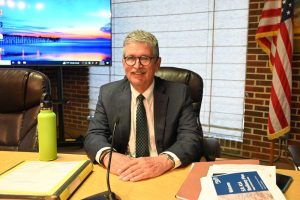
To include your event in the Briefing and Live Calendar, please fill out this form.
Weather: Mostly cloudy. A chance of showers with a slight chance of thunderstorms in the afternoon. Highs in the lower 80s. Southwest winds 10 to 15 mph with gusts up to 25 mph. Chance of rain 40 percent. Sunday Night: Partly cloudy. Cooler with lows in the mid 50s. West winds 5 to 10 mph.
Today at the Editor’s Glance:
Grace Community Food Pantry, 245 Education Way, Bunnell, drive-thru open today from 1 to 4 p.m. The food pantry is organized by Pastor Charles Silano and Grace Community Food Pantry, a Disaster Relief Agency in Flagler County. Feeding Northeast Florida helps local children and families, seniors and active and retired military members who struggle to put food on the table. Working with local grocery stores, manufacturers, and farms we rescue high-quality food that would normally be wasted and transform it into meals for those in need. The Flagler County School District provides space for much of the food pantry storage and operations. Call 386-586-2653 to help, volunteer or donate.
 World Cup: Costa Rica and Japan are first up at 5 a.m. Japan can advance to the next round with a win. Then Belgium and Morocco at 8 a.m. Belgium, too, can advance with a win. At 11 it’s Croatia and Canada, with both teams desperate for a win if they are to keep their chances alive, and finally the marquee match of the day, Spain and Germany, with Spain in position to advance with a win and Germany still nursing their stunning loss to Japan and in need of a win to keep their chances alive. A tie will not do, though it won’t be necessarily eliminated them they tie.
World Cup: Costa Rica and Japan are first up at 5 a.m. Japan can advance to the next round with a win. Then Belgium and Morocco at 8 a.m. Belgium, too, can advance with a win. At 11 it’s Croatia and Canada, with both teams desperate for a win if they are to keep their chances alive, and finally the marquee match of the day, Spain and Germany, with Spain in position to advance with a win and Germany still nursing their stunning loss to Japan and in need of a win to keep their chances alive. A tie will not do, though it won’t be necessarily eliminated them they tie.
In medias res: The Washington Post on Friday ran a piece that sounds familiar: “Florida beaches were already running low on sand. Then Ian and Nicole hit.” With these findings: “But these days the usual sources for sand — nearby underwater mounds and healthy beaches in other parts of the Sunshine State — are running low. What can be found is pricey. Rockwell estimates each house needs at least 275 dump truckloads pushed underneath to be saved — which at the current price of $1,200 a load comes out to $330,000 per home. […] A state report published over the summer — before the two hurricanes hit — found that more than half of Florida’s sandy beaches are critically eroded. […] Development is partly to blame. Sought-after oceanfront buildings take up space that might otherwise be home to protective sand dunes. Rising sea levels and stronger and more frequent hurricanes are also a factor.” We’ve been writing these lines so often. We still have a County Commission that continues to buy the state’s party line about “resiliency,” and not a word about climate change. One correction to the Post article: it understates the cost of dune renourishment in Flagler in the wake of Hurricanes Matthew and Irma by $20 million, maybe because the reporter assumed it was a mistake when told that it cost $20 million, not $2 million. Speaking of climate change: note the tundra specials below.
Now this:
Flagler Beach Webcam:
![]()
The Live Calendar is a compendium of local and regional political, civic and cultural events. You can input your own calendar events directly onto the site as you wish them to appear (pending approval of course). To include your event in the Live Calendar, please fill out this form.
December 2025
Free For All Fridays With Host David Ayres on WNZF
Scenic A1A Pride Meeting
Friday Blue Forum
Acoustic Jam Circle At The Community Center In The Hammock
Rotary’s Fantasy Lights Festival in Palm Coast’s Town Center
Kwanzaa Celebration
Flagler Beach Farmers Market
Coffee With Flagler Beach Commission Chair Scott Spradley
Grace Community Food Pantry on Education Way
Gamble Jam at Gamble Rogers Memorial State Recreation Area
Rotary’s Fantasy Lights Festival in Palm Coast’s Town Center
ESL Bible Studies for Intermediate and Advanced Students
Grace Community Food Pantry on Education Way
Palm Coast Farmers’ Market at European Village
Al-Anon Family Groups
For the full calendar, go here.
![]()

“Fragile” just does not appear to be a proper term for a rugged, essentially uninvaded landscape covering tens of thousands of square miles–a place so vast and unpeopled that if anyone could figure out how to steal Italy, Alaska would be a place to hide it. Meanwhile, earnest ecologues write and speak about the “fragile” tundra, this “delicate” ocean of barren land. The words sound effete, but the terrain is nonetheless vulnerable. There is ice under the tundra, mixed with soil as permafrost, in some places two thousand feet deep. The tundra vegetation, living and dead, provides insulation that keeps the summer sun from melting the permafrost. If something pulls away the insulation and melting occurs, the soil will settle and the water may run off. The earth, in such circumstances, does not restore itself. In the nineteen-sixties, a bulldozer working for Geophysical Service, Inc., an oil-exploration company, wrote the initials G.S.I. in Arctic Alaskan tundra. The letters were two hundred feet from top to bottom, and near them the bulldozer cut an arrow–an indicator for pilots. Thermokarst (thermal erosion) followed, and slumpage. The letters and the arrow are now odd-shaped ponds, about eight feet deep. For many generations that segment of tundra will say “G.S.I.” Tundra is even sensitive to snow machines. They compress snow, and cut off much of the air that would otherwise get to the vegetation. Evidence appears in summer. The snow machines have left brown trails on ground they never touched.
–From John McPhee’s Coming Into the Country (1976).










































Leave a Reply